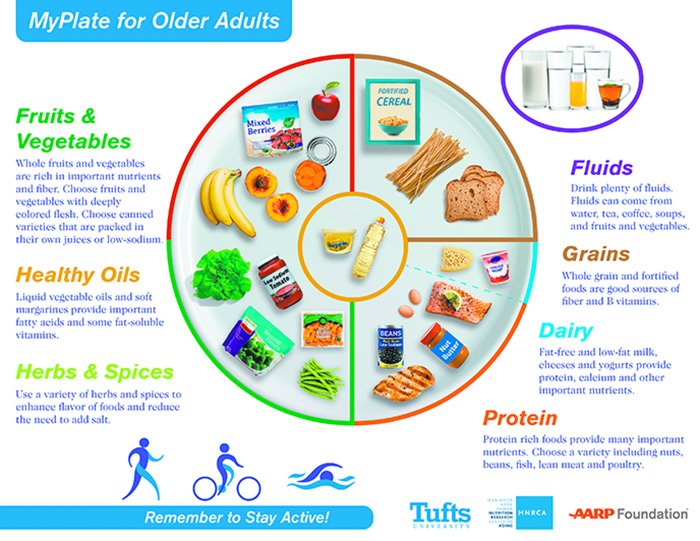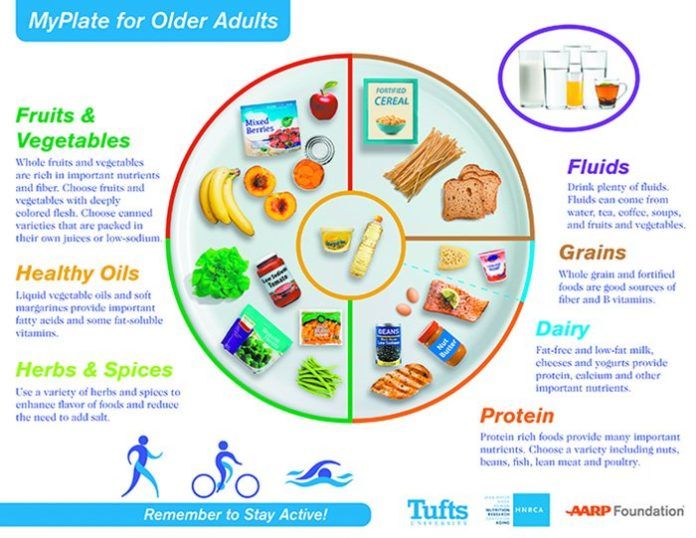If you’ve got your AARP card but you’re still eating the way you did in your 20s, it’s time for your diet to act your age. While most nutritional guidance is “ageless,” you do need to make some adjustments to fit the changing needs of your aging body. As activity levels decrease and muscle mass declines, for example, older people need to consume fewer calories to avoid gaining weight. Because you need fewer calories, however, it’s more important to choose foods that are nutrient dense – concentrated sources of vitamins, minerals, fiber, protein and other essentials. You may also need more of certain nutrients or be at risk for deficiency because your body absorbs some less well.
Tufts experts recently introduced an updated MyPlate for Older Adults graphic, which emphasizes these special nutritional needs in a framework of the 2015-2020 Dietary Guidelines for Americans (DGAs). The icon was developed by nutrition scientists at the Jean Mayer US Department of Agriculture Human Nutrition Research Center on Aging at Tufts with support from the AARP Foundation. It’s the fourth version of this graphic; an accompanying website was launched at <hnrca.tufts.edu/myplate>.
“It is never too late to make smart changes in your diet,” says Alice H. Lichtenstein, DSc, director of Tufts’ HNRCA Cardiovascular Nutrition Laboratory. “Shifting towards healthier food choices can improve symptoms or decrease risk for developing chronic diseases such as type 2 diabetes, hypertension and heart disease – all of which are more common in older than younger adults.”
“Many people are not aware of the key role that healthy eating patterns play in improving their bodily function such as that of brain, eye and the immune system,” says Simin Nikbin Meydani, DVM, PhD, director of the HNRCA.
GETTING ENOUGH: The foods highlighted in the new graphic are good examples of nutrient-dense choices, which was also an emphasis in the latest DGAs. What’s the difference? A large peach and five ounces of non-diet cola each contain about 65 calories, but the peach contains fiber, vitamins A and C, potassium and other nutrients – it’s more nutrient dense. The cola is energy dense because of its high sugar content, but provides no healthy nutrients. Even within the fruit and vegetable category, substituting fresh spinach for iceberg lettuce can boost nutrient intake.
Another reason to make smart food choices as you get older is that it can be harder to get enough of certain key nutrients than when you were younger. This can occur either because your body and lifestyle have changed or because your needs have increased with age. Examples include:
– Vitamin B12—The amount of B12 your body needs doesn’t change with age, but your ability to obtain this vitamin from food might. People with low levels of stomach acids, whether due to aging or the use of certain medications, can’t extract as much dietary B12. The vitamin B12 found in fortified foods, such as breakfast cereals, is already in a free form that the body can use.
– Vitamin D -With age, the body loses some of its natural ability to make vitamin D from sun exposure, and older people often spend less time out in the sun.
– Calcium -The amount of calcium needed to maintain bone density and prevent fractures increases for women over age 50 and for all adults over age 70. Experts advise getting as much of your daily calcium needs as possible from dietary sources, such as fat-free or low-fat yogurt.
– Fiber – Like other systems in your body, your GI tract no longer functions as efficiently when you get older. Fiber can help with constipation, and has also been linked to lower risk of a variety of diseases associated with aging.
– Water – Your sense of thirst diminishes with age, so you may need to pay closer attention to getting enough water and other healthy fluids to prevent dehydration.
RETHINKING YOUR PLATE:The new MyPlate for Older Adults icon depicts a colorful plate with images to encourage older Americans to follow a healthy eating pattern bolstered by physical activity.
The plate is composed of approximately:
– 50% fruits and vegetables;
– 25% grains, most of which are whole grains; and
– 25% protein-rich foods such as nuts, beans, fish, lean meat, poultry, and fat-free and low-fat dairy products such as milk, cheeses, and yogurts.
The new icon also shows good sources of fluids, such as water, milk, tea, soup and coffee; heart-healthy fats such as vegetable oils and soft margarines. The accompanying website also spotlights herbs and spices to be used in place of salt to lower sodium intake (see next page).
SPICE UP YOUR LIFE
Nearly all Americans eat too much sodium in the form of salt. Eating less salt generally results in lowered blood pressure, hence, lower risk of heart disease, stroke, congestive heart failure and kidney disease.
Most dietary salt comes from pre-prepared foods, eaten either at home or in restaurants. When you’re in control of seasoning, experiment with using herbs and spices instead of salt and customize your spices to your taste preferences. Some common spices to use instead of salt include:
Allspice: For meats, fish, poultry, soups, stews and desserts
Basil: For soups, salads, vegetables, fish and meats
Cayenne pepper: For meats, poultry, stews and sauces
Celery seed: For fish, salads, dressings and vegetables
Chili powder: For meats, poultry and stews
Cilantro: For meats, sauces, stews and rice
Cinnamon: For salads, vegetables, breads, snacks and meats
Cumin: For meats and poultry
Curry powder: For meats, shellfish and vegetables
Dill weed and dill seed: For fish, soups, salads and vegetables
Garlic powder (not garlic salt): For meats, poultry, fish, vegetables, salads, soups and stews
Ginger: For soups, salads, vegetables and meats
Marjoram: For soups, salads, vegetables, beef, fish and chicken
Onion powder (not onion salt): For meats, poultry, soups and salads
Oregano: For soups, salads, vegetables, meats and chicken
Paprika: For meats, fish, poultry and vegetables
Parsley: For salads, vegetables, fish and meats
Rosemary: For salads, vegetables, fish and meats.
Sage: For soups, salads, vegetables, meats and chicken
Thyme: For salads, vegetables, fish and chicken

STRATEGIES TO SHIFT: Lichtenstein advises older adults to begin by making small shifts in food and beverage choices to improve your overall eating pattern, and then continue to build on them. Making small changes and sticking with them, she says, is the best approach to long-term improvements in eating habits. If you plan on making major changes in your diet, talk with your primary healthcare provider first.
When selecting foods, she recommends:
– Buy a variety of fresh, frozen, or no-salt-added canned vegetables and fruit packed in its own juices, so they are readily available for eating as is or adding to sauces, soups and salads.
– Choose reduced-sodium varieties of beans, salad dressings and baked products, as available.
– If only varieties packed in sugary syrup or salty fluids are available, give them a quick rinse before serving.
– Dried fruit and unsalted nuts make good portable snacks.
– When food is not prepared at home, try to identify, in advance, nearby restaurants and other food outlets that offer options consistent with healthy dietary patterns. When in doubt, ask the restaurant for information. Chain restaurants usually post nutrition information on their website and sometimes have it available in the restaurant, and many restaurants allow some customization of entres to better fit into a healthy dietary pattern.
























